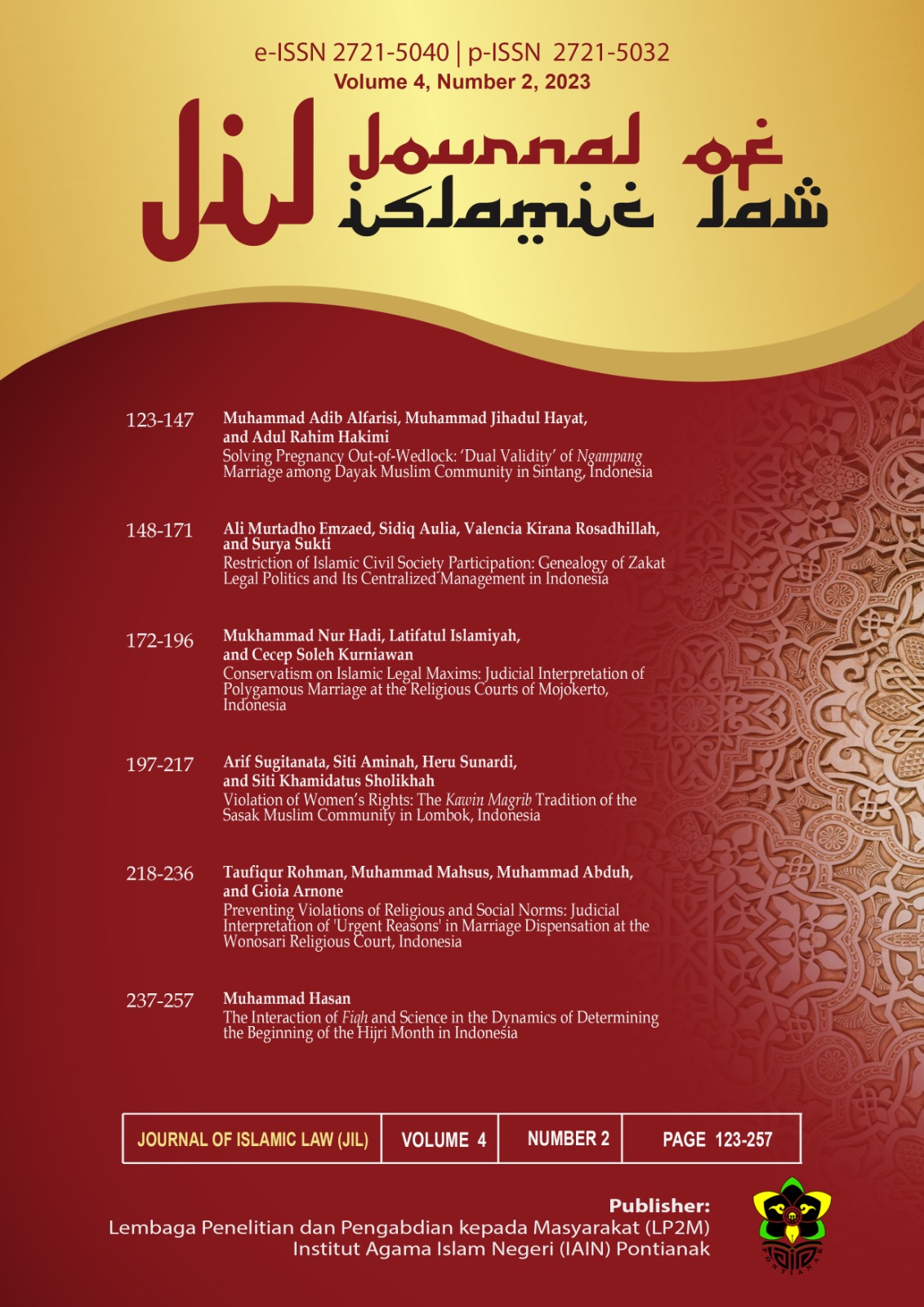Solving Pregnancy Out-of-Wedlock: ‘Dual Validity’ of Ngampang Marriage among Dayak Muslim Community in Sintang, Indonesia
DOI:
https://doi.org/10.24260/jil.v4i2.1283Keywords:
Pregnancy Out-of-Wedlock, Marriage by Pregnancy, Dual Validity, Ngampang Marriage, Customary LawAbstract
According to most scholars of Islamic jurisprudence (jumhūr ʿulamā), marriage due to pregnancy (ngampang) is permissible as long as it is conducted under fiqh (Islamic jurisprudence) rules. Its validity is not contingent upon the situation/locus ‘in front of the state official’. It means that there is no significance in remarrying before the state official if an Islamic marriage has previously been performed beyond the walls of the state building. In reality, however, the community—in this context, the Muslim community of Sintang—often remarries before a marriage registrar to achieve state recognition in the case of marriage due to pregnancy. This article portrays how the Sintang Muslim community legalizes marriage status due to pregnancy. Data were collected through interviews. This article argues that in order to obtain state recognition of their marriage due to pregnancy, the Muslim community of Sintang often performs twofold marriage ceremonies. The first is according to customary standards (in line with the Statute of the Sintang Kingdom) and following Islamic rules. The second is according to national procedure (in front of a state official), which applies the same Islamic terms. It indicates that, in terms of resolving the issue of pregnancy out-of-wedlock, the Sintang Muslim community has to go through two standards that are not substantively contradictory to each other. Both standards actually rest on the same principles in Islamic law.
References
Abdur Rahman Ghazaly. Fikih Munakahat. Bogor: Kencana, 2003.
Agustina, Arifah Millati. “Between Culture and the Sacredness of Fiqh: The Role of Lebe in Child Marriage Practices in Brebes, Indonesia.” Journal of Islamic Law (JIL) 3, no. 2 (August 31, 2022): 212–31. https://doi.org/10.24260/jil.v3i2.858.
Al-Jazīrī, ʿAbd al-Raḥmān, Kitāb al-Fiqh. Miṣr: Maktabat al-Tijāriyyah al-Kubrā, 1969.
Al-Zuhaīlī Wahbah, Al-Fiqh al-Islāmī. Bayrūt: Dār al-Fikr, 1991.
Anam, Saiful. The Officials of the Indonesian Ulama Council (MUI) in Sintang Regency, August 30, 2021.
Baraie, Bahman, Mehdi Rezaei, Haidar Nadrian, and Hossein Matlabi. “What Socio-Cultural Factors Encourage Child Marriage in Sanandaj, Iran? A Qualitative Study.” Child & Youth Services, January 20, 2023, 1–22. https://doi.org/10.1080/0145935X.2023.2167708.
Bello, Abdulmajeed Hassan. “The Punishment for Adultery in Islamic Law and Its Application in Nigeria.” Journal of Islamic Law and Culture 13, no. 2–3 (October 2011): 166–82. https://doi.org/10.1080/1528817X.2012.733132.
Bowen, John R. Islam, Law, and Equality in Indonesia: An Anthropology of Public Reasoning. Cambridge: Cambridge University Press, 2003.
Bowen, John Richard. “Shari’a, State and Social Norms in France and Indonesia.” ISIM Paper, 2001, 1–36.
Darlis, Syamsul. “Marriage for Covering Disgrace: The Practice of Kawi’ Pura Tradition in the East Kolaka Muslim Society.” Al-Ahwal: Jurnal Hukum Keluarga Islam 15, no. 1 (2022): 21–38. https://doi.org/10.14421/ahwal.2022.15102.
Eka, Nur. Actor of Sampang Practice, August 28, 2021.
Engelcke, Dörthe. “Establishing Filiation (Nasab) and the Placement of Destitute Children into New Families: What Role Does the State Play?” Journal of Law and Religion 34, no. 3 (2019): 408–32. https://doi.org/10.1017/jlr.2019.45.
Engelcke, Dörthe, and Nadjma Yassari. “Child Law in Muslim Jurisdictions: The Role of the State in Establishing Filiation (Nasab) and Protecting Parentless Children.” Journal of Law and Religion 34, no. 3 (2019): 332–35. https://doi.org/0.1017/jlr.2019.40.
Farabi, Al. “The State Penghulu vs the Non-State Penghulu: The Validity and Implementing Authorities of Indonesian Marriage.” Justicia Islamica: Jurnal Kajian Hukum dan Sosial 17, no. 2 (2020): 343–64.
Fauzi, Muhammad Latif. Aligning Reigious Law and State Law: Street-Level Bereaucrast and Muslim Marriage Practices in Indonesia. Leiden University, 2021.
———. Aligning Religious Law and State Law: Negotiating Legal Muslim Marriage in Pasuruan, East Java. Leiden Studies in Islam and Society 18. Boston: Brill, 2023.
Hasan, Fahadil Amin Al, and Deni Kamaluddin Yusup. “Dispensasi Kawin dalam Sistem Hukum Indonesia: Menjamin Kepentingan Terbaik Anak Melalui Putusan Hakim.” Al-Ahwal: Jurnal Hukum Keluarga Islam 14, no. 1 (2021): 86–98. https://doi.org/10.14421/ahwal.2021.14107.
Hitchcock, Michael, Victor T. King, and Mike Parnwell, eds. Tourism in South-East Asia. Abingdon, Oxon: Routledge, 2019.
Hooker, M.B. “Adat and Islam in Malaya.” Bijdragen Tot de Taal-, Land- En Volkenkunde/Journal of the Humanities and Social Sciences of Southeast Asia 130, no. 1 (1974): 69–90. https://doi.org/10.1163/22134379-90002707.
Inayah, Nurul. “Penetapan Dispensasi Nikah Akibat Hamil di Luar Nikah di Pengadilan Agama Yogyakarta Tahun 2010-2015 (Analisis Hukum Acara Peradilan Agama).” Al-Ahwal: Jurnal Hukum Keluarga 10, no. 2 (2017): 178–93. https://doi.org/10.14421/ahwal.2017.10206.
Ismail, Ismail, Novi Hendri, and Putri Rahmah Nurhakim. “Minangkabau’s Doro Tradition: Coexistence of Customary Law and Islamic Law in Caning Punishment.” Samarah: Jurnal Hukum Keluarga dan Hukum Islam 7, no. 1 (March 31, 2023): 579–601. https://doi.org/10.22373/sjhk.v7i1.15904.
Kania, Dede, Siti Nur Fatoni, Mochammad Rizky Afriansyah, and Hazar Kusmayanti. “Marriage Dispensation Since the Decision of the Constitutional Court Number 22/Puu-Xv/2017.” Jurnal Hukum Islam 19, no. 1 (2021): 43–64. https://doi.org/10.28918/jhi.v19i1.3491.
Laksono, Agung D., Ratna D. Wulandari, Nikmatur Rohmah, and Ratu Matahari. “Unmarried Women and Unintended Pregnancy: An Indonesian Cross-Sectional Study.” Indian Journal of Community Medicine 48, no. 2 (2023): 361–63. https://doi.org/10.4103/ijcm.ijcm_325_22.
Lukito, Ratno. Hukum Sakral dan Kukum Sekuler: Studi tentang Konflik dan Resolusi dalam Sistem Hukum Indonesia. Yogyakarta: Pustaka Alvabet, 2008.
———. “Islamic Law and Adat Encounter: The Experience of Indonesia.” McGill University, 1997.
———. Legal Pluralism in Indonesia. London: Routledge, 2012.
“Majelis Ulama Indonesia Fatwa No. 11 of 2012 on the Status of Children Resulting from Zina and Treatment towards Them.”
“Marriage Law No. 1 of 1974.”
Maulana, Arie Rizky. Actor of Sampang Practice, June 21, 2021.
Mufied, Khalidul. The Officials of the Indonesian Ulama Council (MUI) in Sintang Regency, August 27, 2021.
Muqaffi, Ahmad, Rusdiyah Rusdiyah, and Diana Rahmi. “Menilik Problematika Dispensasi Nikah dalam Upaya Pencegahan Pernikahan Anak Pasca Revisi UU Perkawinan.” Journal of Islamic and Law Studies 5, no. 2 (2022): 361–77. https://doi.org/10.18592/jils.v5i3.5914.
Muthohar AR, Ahmad. Islam Dayak: Dialektika Identitas Dayak Tidung di Kalimantan. Semarang: Fatawa Publishing, 2015.
Nasir, Mohamad Abdun. “Religion, Law, and Identity: Contending Authorities on Interfaith Marriage in Lombok, Indonesia.” Islam and Christian–Muslim Relations, Routledge Law in Asia, 31, no. 2 (April 2, 2020): 131–50. https://doi.org/10.1080/09596410.2020.1773618.
Nijo. Head of the Office of Religious Affairs in Sintang District, May 8, 2021.
Nisa, Eva F. “Battling Marriage Laws : Early Marriage and Online Youth Piety in Indonesia.” Hawwa 18, no. 2–3 (2020): 76–102. https://doi.org/10.1163/15692086-12341387.
Ntoimo, Lorretta Favour Chizomam, and Favour Chukwunonyerem Ntoimo. “Who Owns a Child? Conflict of Culture and Human Right in the Dissolution of Customary Law Marriage in Nigeria.” Journal of Divorce & Remarriage 62, no. 5 (July 4, 2021): 398–409. https://doi.org/10.1080/10502556.2021.1871842.
Nurlaelawati, Euis. “Managing Familial Issues. Unique Features of Legal Reform in Indonesia.” In Islam in Indonesia, edited by Jajat Burhanudin and Kees van Dijk, 123–38. Amsterdam: Amsterdam University Press, 2018.
Nurlaelawati, Euis, and Stijn Cornelis van Huis. “The Status of Children Born out of Wedlock and Adopted Children in Indonesia: Interactions between Islamic, Adat, and Human Rights Norms.” Journal of Law and Religion 34, no. 3 (2019): 356–82. https://doi.org/10.1017/jlr.2019.41.
Ojogbo, Samuel E., and Omerionwan K. Edu. “Comparing Maintenance and Property Rights in Marriage under Customary Law and Statutory Law in Africa.” Oxford University Commonwealth Law Journal 22, no. 2 (July 3, 2022): 229–52. https://doi.org/10.1080/14729342.2022.2153508.
Prabowo, Bagya Agung. “Pertimbangan Hakim dalam Penetapan Dispensasi Perkawinan Dini Akibat Hamil di Luar Nikah pada Pengadilan Agama Bantul.” Jurnal Hukum Ius Quia Iustum 20, no. 2 (2013): 300–317. https://doi.org/10.20885/iustum.vol20.iss2.art7.
“Presidential Instruction No. 1 of 1991 on Compilation of Islamic Law.”
Putri Yanti, Fitri. Actor of Sampang Practice, June 21, 2021.
Radan, Peter, Denise Meyerson, and Rosalind F. Atherton, eds. Law and Religion. London: Routledge, 2004.
Ridlo, Muhammad Rosyid, Imron Rosyadi, and Muthoifin Muthoifin. “The Law of Nasab for Children Born Outside of Legal Marriage According to Imam Ibn Qayyim al-Jauziyyah.” Profetika: Jurnal Studi Islam 23, no. 2 (2022): 321–30. https://doi.org/10.23917/profetika.v23i2.19671.
Ṣabīq, al-Sayyid. Fiqh al-Sunnah. Jakarta: PT Pena Pundi Aksara, 1983.
Salenda, Kasjim. “Abuse of Islamic Law and Child Marriage in South-Sulawesi Indonesia.” Al-Jami’ah: Journal of Islamic Studies 54, no. 1 (2016): 95–121. https://doi.org/10.14421/ajis.2016.541.95-121.
Salma, Salma, Hasanatul Wahida, and Muhammad Adib bin Samsudin. “Ignoring Family Law Administrative Procedure: Falsifying Death of Spouses for the Registration of New Marriage in Lengayang Muslim Community.” Al-Ahwal: Jurnal Hukum Keluarga Islam 15, no. 1 (2022): 1–20. https://doi.org/10.14421/ahwal.2022.15101.
Sidahmed, Abdel Salam. “Problems in Contemporary Applications of Islamic Criminal Sanctions: The Penalty for Adultery in Relation to Women.” British Journal of Middle Eastern Studies 28, no. 2 (November 2001): 187–204. https://doi.org/10.1080/13530190120083077.
Sunariyo, Edy. The Officials of the Indonesian Ulama Council (MUI) in Sintang Regency, August 23, 2021.
Sushkova, Iuliia N. “Marriage and Family Customs of the Finno-Ugric Peoples of the Volga Region: Legal and Anthropological Analysis (Late XIX – Early XX Century).” Finno-Ugric World 14, no. 1 (April 22, 2022): 87–99. https://doi.org/10.15507/2076-2577.014.2022.01.87-99.
Susilo, Singgih, Novia Fitri Istiawati, Muhammad Aliman, and Muhammad Zulfi Alghani. “Investigation of Early Marriage: A Phenomenology Study in the Society of Bawean Island, Indonesia.” Journal of Population and Social Studies [JPSS] 29, January-December (2021): 544–62.
Syahrel, Oeti. Sintang Regency Malay Traditional Figure, May 8, 2021.
“The 1948 Sintang Kingdom Law”
Turmidzi, Slamet. The Officials of the Indonesian Ulama Council (MUI) in Sintang Regency, August 28, 2021.
Uddin, Islam. “Reformulation of Islamic Matrimonial Law: British Muslims, Contemporary Understandings and Normative Practices.” Journal of Muslim Minority Affairs 40, no. 1 (January 2, 2020): 6–25. https://doi.org/10.1080/13602004.2020.1737413.
Wai, Robert. “The Interlegality of Transnational Private Law.” Law and Contemporary Problems 71, no. 3 (2008): 107–27.
Yakin, Ayang Utriza. “Establishing Filiation Relationships (Nasab) of Children Born of Unlawful Sex (Zina): Legal Change, Positivization, and Standardization in Indonesian Islamic Courts.” In Canon or Code? Standardising and Transmitting Islamic Law. UCL - SSH/RSCS - Institut de Recherche Religions, Spiritualités, Cultures, Sociétés, 2022.
Zainuddin Ali. Hukum Perdata Islam di Indonesia, Jakarta: Sinar Grafika, 2006.
Downloads
Published
How to Cite
Issue
Section
License
Copyright (c) 2023 Muhammad Adib Alfarisi, Muhammad Jihadul Hayat, Adul Rahim Hakimi

This work is licensed under a Creative Commons Attribution-NonCommercial 4.0 International License.










